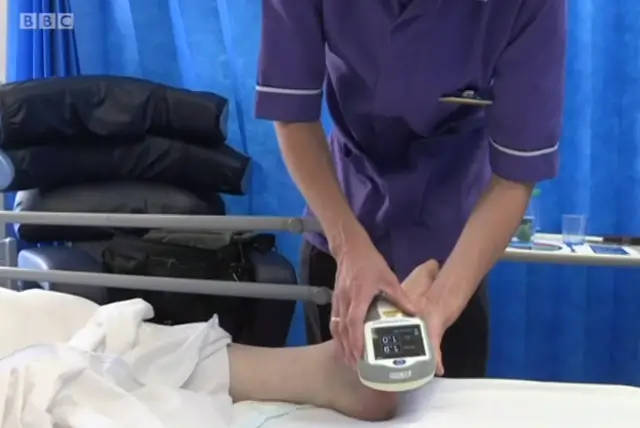Andy shares this news from the Isle of Wight NHS Trust. Ed
An award winning innovative non-invasive device for early detection of pressure ulcers (“bedsores”), used by Isle of Wight NHS Trust staff, featured on BBC South Today news on Monday 28th August (watch on BBC iPlayer – skip to 2.21).
At this year’s Patient Safety Awards, Isle of Wight NHS Trust and Bruin Biometrics were awarded Best Product or Innovation for Patient Safety for use of the SEM Scanner by a panel of independent judges. An estimated 18 to 25 percent of patients in acute care and long-term care settings suffer from pressure ulcers, which cost the NHS £2.1bn per annum.
Early detection vital
The winning project evaluated how early detection can support nurses in delivering effective care, has resulted in a complete elimination of hospital-acquired pressure ulcers in those wards. The judges felt that this was truly transformational for the sector, with a visible and measurable impact on patient safety improvement.
Glenn Smith, Tissue Viability Nurse and Patient Safety Lead at St. Mary’s Hospital, Isle of Wight NHS Trust, said,
“We are extraordinarily proud of the tissue viability and nutrition team and what they have been able to accomplish. We have since expanded the program, and have not seen a single pressure ulcer on patients that we have scanned where we implemented the SEM Scanner.
“The information from the scanner allows us to intervene before the point that pressure injuries become obvious. We are starting to scan people on admission, and we also now can tell within twenty-four hours if a specific intervention is working and can personalise patient care plans appropriately. Now, where we have the scanners, I don’t have to wait until the skin goes red to avoid a pressure ulcer.”
How it works
The sub-epidermal moisture (SEM) scanner works by measuring changes in moisture under the skin when placed on areas where damage is most likely to occur, such as the heels and lower back. The device emits a small electrical current through the skin surface and, depending on the amount of electrical resistance, it is able to report changes under the skin that will lead to a pressure sore developing.
The scanner was used at St. Mary’s Hospital for a two month evaluation in 2015 and of the 35 patients that were scanned, none went on to develop pressure ulcers. Scanners are now being used on two wards with a view to being used across the hospital. The Tissue Viability Service is also using the device to identify pressure ulcers on patients when they are first admitted to hospital.
Roll-out would save £600,000 a year
Glenn continued:
“Up until now the only way to diagnose pressure ulcers was through regular inspection by nursing staff, but by the time the ulcer is identified, it’s too late, the damage to the skin has been done. Once a bed sore has developed, it can take anything up to six months to heal, so we need early detection and before the skin is visibly damaged.
“When we used the scanner in the trial we reduced pressure ulcers in the patients scanned to zero. This is a real achievement that is making a significant difference to the comfort of patients and the quality of their care. Rolling out this initiative across our hospital would save nearly £600,000 a year as well as release nursing time but, most importantly, further improve the care for those patients vulnerable to pressure ulcers.”





